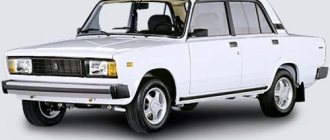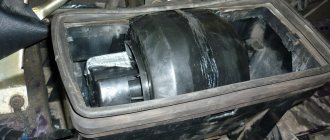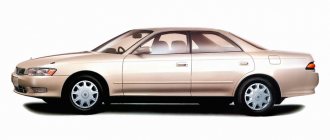Cars of the Chevrolet Niva model received the VAZ-2123 engine, which is quite powerful for this type of car, the main design features of which are a 4-cylinder vertical mechanism. The Chevrolet Niva engine has a built-in fuel injection control system and also complies with European Euro 2 standards for toxic emissions.
Comparing the new modification of the VAZ-2123 with previous analogues, one immediately notices one of the main advantages for the motorist - reduced noise level. This result was achieved thanks to the use of hydraulic chain tensioners, as well as a single-row chain device.
The reason for the reduced noise production is the presence of a hydraulic support for the valves. This engine has one more difference from previous models of this engine - the ability to install knock sensors on the cylinder blocks, which is provided by the bosses.
Technical characteristics of VAZ-2123
Download .xls file
xls
Download picture
Send by email
| OPTIONS | MEANING |
| Brand | Engine VAZ-2123 |
| Type | Powered by gasoline, has 4 cylinders, electronically controlled fuel injection volume control system |
| Power | Up to 80 hp |
| Maximum engine capacity | 1690 cm 3 |
| Gas tank capacity | Up to 58 l |
| Highest developed speed | 140 km/h |
| Achievable torque | 127.5 Nm |
| Average gasoline consumption per 100 km. mileage: | |
| when driving outside the city | Up to 8.8 l |
| in urban environments | Up to 14.1 l |
| with variable driving in different conditions | Up to 10.8 l |
| Maximum compression level | 9.3 atm. |
| Diameter of one cylinder | 82 mm |
| Number of valves used in the device | 8 |
| Minimum crankshaft speed | 750 rpm |
| Weight of the entire structure | 127 kg |
This motor can be installed on Chevrolet Niva, Niva 21213 and 21214 models.
Replacing the valve mechanism
It must be taken into account that the modernization of the Chevrolet Niva power unit will not have a significant impact in terms of improving the performance of the car. This is due to the fact that all the features of the vehicle are designed for high cross-country ability, and not for high-speed performance. Consequently, the money and time spent on chip tuning, valve mechanism replacement, and engine upgrades do not always give the desired result.
In order for the modernization of a domestic SUV to bring a visible effect, attention should be paid to improving traction characteristics, which is already one of the advantages of this vehicle. In this direction, you should pay attention to the following points:
- Boring the standard piston to an increased diameter. This will make it possible to increase the fuel volume of the engine. Just a two millimeter difference will allow you to store not 1.7, but 1.85 liters of fuel, which is not so little.
- Improving the piston itself in the power unit will add another 0.2 liters to the volume.
- A complete replacement of the piston mechanism with a 2123 engine cover with a version with a diameter of 88 millimeters will increase the volume to two liters.
An important point is that any attempts to tune the engine, carried out by an ignorant person without the participation of a specialist, can lead to the opposite effect or failure of the unit.
Design features of the VAZ-2123 engine
The camshaft mechanism in the VAZ-2123 has not undergone any significant changes compared to previous models. It still has a single-row bush-roller chain, which is why all the sprockets in the engine structure have a single-row structure. Thus, the designers of this model have improved the operation of the oil transfer pump. You can read about the oil change itself here: Niva Chevrolet oil change.
Otherwise, all components remain the same and do not differ from previous models, such as 21214. This can be judged based on the installation of a spring-hydraulic system, which has been used in VAZ mechanisms for many years.
The water pump as well as the generator are driven by interaction with a pulley mounted on the crankshaft and driving the above-mentioned devices using a serpentine belt.
The standard belt used in the Chevy Niva engine is called “GATES” and serial number 58436 5РК1888.
Its characteristics:
- standard belt length – 188.8 cm;
- belt width – 1.7 cm;
- This belt has only 5 wedges.
One of the most noticeable changes in the new engine includes a redesigned engine compartment and a redesigned axle beam. The change in shape occurred due to a design feature - the lack of fastening of the front axle gearbox directly to the engine.
Therefore, this Niva sample is incompatible with engine parts and fasteners from earlier cars from this manufacturer.
Air intake system on VAZ-2123
The new Chevrolet Niva car has a completely new air intake system. The main difference is a significant increase in the volume of the air filter, which can be seen in the significantly larger body.
Elements such as the receiver, intake pipes and the pipe, replaced with a throttle version, were also structurally changed.
The electronic component of the car has also undergone changes. The main control of the motor is carried out thanks to the BOSCH controller, sample MP 7.9.7. In some individual copies, the “January” 7.2 system was also installed.
This not only affects the user-friendly interface, but also allows you to control fuel consumption due to an improved injection control system, which has a pair-parallel design. Thus, this machine has the ability to comply with Euro-2 standards.
To reduce the emission of harmful substances from a car, you can install a phased gasoline injection system, which will help raise the safety bar to the Euro-3 level and at the same time optimize the use of fuel due to its more accurate supply.
Other changes related to the operation of the Chevrolet Niva engine include:
- Fuel rail using a SIEMENS type injector;
- The ignition module has remained the same since the days of the VAZ-2112;
- The generator installed on the Chevrolet Niva has serial number 9402.3701-01. The designers chose the top location for it;
- For ignition, the car uses a starter model 5722.3708. Its main feature is the presence of a planetary gearbox. The maximum possible power is 1.55 kV;
- A plastic casing was installed to protect the motor.
Major changes
The transmission in the motor of the series in question is called Gates. This is a standard belt with the following characteristics:
- standard length – 1888 mm;
- element width – 17 mm;
- number of wedges – 5 pcs.
In the updated 2123 engine, design nuances also include the following updates: a different configuration of the engine compartment and a redesigned bridge beam. The shape has changed due to the absence of a front axle gearbox clamp directly to the power unit. In this regard, the option under consideration is incompatible with accessories and elements of earlier versions from this manufacturer.
Malfunctions of VAZ-2123
| Causes | How to fix |
| Engine won't start | |
| There are several main reasons for problems with starting the Chevrolet Niva VAZ-2123 engine: 1. Severe contamination of the fuel line, which caused insufficient fuel to enter the engine; 2. The filter in the connection between the gasoline supply pipe and the engine has not been replaced for a long time; 3. Problem with the feed pump (does not pump, does not pump enough fuel). | Basically, you can fix the problem yourself: 1. To prevent clogging of the fuel system, you need to rinse with water or blow with compressed air; 2. Repair or replace the fuel injection unit; 3. Clean or change the filter. |
| Constantly stalls while driving or idling | |
| 1. Lack of the required level of pressure in the gasoline supply system (also true for a field with a diesel engine); 2. Problems with the idle control device; 3. Air getting into the fuel supply hoses, unstable operation of the crankcase ventilation, air getting into the brake boosters, which should be sealed by default. | 1. Check the serviceability of the pump, repair or replace it with a new one; 2. It is quite difficult to repair the idle air control yourself, so an easier solution would be to completely replace it with a new one; 3. If air is trapped in places where it should not be, it is worth checking all the clamps, tightening them, and making sure that there are no damaged hoses and fasteners. |
| Engine power is not rated | |
| 1. Problem with the throttle valve, its incomplete opening; 2. Also, due to a malfunction of the electronic component, namely the throttle position sensor, problems may arise with supplying the required amount of gasoline to the engine; 3. Inoperative or faulty ignition system in the car. | 1. Carry out diagnostics and adjustment of the throttle. To do this, you do not need to have any special skills, which allows any car enthusiast to cope with the task; 2. If there are problems with electronic sensors, the best solution is to completely replace them; 3. Check the serviceability of the spark plugs and the presence of a working battery. |
Power mismatch with nominal value
In this regard, the 2123 engine exhibits the following problems:
- Incomplete opening of the throttle valve. The throttle should be checked and adjusted. No special skills are required here; you can easily solve the problem yourself.
- Failure of the electronic element in the throttle position sensor, causing an insufficient supply of gasoline to the working chamber. In this case, it is best to simply replace the faulty indicators with new analogues.
- Irregularities in the ignition system. Check the batteries and the condition of the spark plugs.
Tuning the VAZ-2123 engine
There are several basic ways that, with the help of small changes in the design of the engine, can change its characteristics and increase power.
But you should not expect any high results due to the design features of the mechanism produced by a domestic manufacturer.
Therefore, immediately before attempting to modify the VAZ-2123, it is worth weighing the pros and cons.
Still, there are several ways to slightly optimize the operation of this sample Chevy Niva engine:
- The first thing to try is to increase the piston stroke, which will increase the volume from 1.7 to 1.9 liters. To do this, it is necessary to bore to increase the inner diameter of the liners. Then you need to select pistons and piston rings for the new size. You also need to install a crankshaft with elongated arms and shortened connecting rods into the engine. But replacing the crankshaft and crankshaft of the engine will not be enough. Due to the increase in volume, it is necessary to increase the supply of the combustible mixture to the cylinders and improve their ventilation. Therefore, the cylinder head (cylinder head) also undergoes changes. To do this, you need to bore the intake and exhaust windows and replace the valves with larger ones. Valve seats are also bored out and replaced.
You can also completely replace the exhaust system, while increasing the diameter of the exhaust pipes, and replace the catalyst with a flame arrester.Important! These changes to the engine entail the need to reconfigure the operation of the fuel supply system, since with standard configurations and an increased volume, the fuel supplied to the cylinders will not be enough. That is, you will need to perform chip tuning.
Thanks to the work performed, power increases by 15%, which also leads to an increase in fuel consumption.
- The next thing you can pay attention to when tuning the Niva Chevrolet engine is to improve the cylinders for more efficient use of the replaced piston. To do this, they will need to be bored to a width of 84 mm. Thanks to the work done, the car owner will receive even greater engine capacity in the new Chevrolet car, reaching 1.9 liters of fuel. But it is worth considering that such actions require partial replacement of some parts in the car.
- In order to get an additional increase in power in the Chevrolet Niva VAZ-2123 engine, you need to replace the carburetor with a new one, change the standard connecting rods to a lighter analogue.
Reliability, weaknesses, maintainability
Reliability
VAZ-2123 is considered a reliable engine. Car owners are satisfied with its technical characteristics and high throttle response.
The main factors characterizing the reliability of any motor are the mileage before major repairs and the safety margin, i.e. the ability to boost the motor.
From Table 1 it can be seen that the unit does not have any problems with these parameters. Car enthusiasts on forums confirm this. For example, forum member V writes: “... I have a Chevy, 350 thousand without cap. repairs, 1.5 liters of oil from replacement to replacement, at 240 the cylinder head was replaced and that’s all…”. His communication colleague P supports: “... the engine (this is subjective) is able to last up to 300 thousand km. (how to ride and how to follow).”
The manufacturer keeps internal combustion engine reliability issues under constant control. Each engine improvement includes developments that increase reliability. So, the pump was replaced, the pan and air intake system were changed, and other improvements were made.
Updating engine components is also aimed at increasing the reliability and durability of the unit. For example, the timing chain has a service life of 150 thousand km (which cannot be said about its tensioner), the working surface of the pistons has an applied layer of tin, and when they meet the valves, the latter do not bend.
Car owners emphasize the need for proper engine maintenance. The service life without repair depends on its quality and timeliness.
VAZ-2123 is easy to tune. But here you need to remember two points:
- The engine design is aimed at high cross-country ability of the vehicle, not speed.
- Increasing power significantly reduces engine life and increases fuel consumption.
At the same time, a simple flashing of the ECU allows you to increase power by 15-20 hp. With.
Weak spots
The most noticeable weak points of the engine are considered to be the following:
- Noisy operation of a cold internal combustion engine. In most cases, this phenomenon is caused by the operation of hydraulic compensators. Unfortunately, they are structurally flawed, their quality leaves much to be desired. The defect is eliminated by replacing the hydraulic compensators or removing them altogether and replacing them with mechanical pushers.
- Loud engine operation at idle. In addition to low-quality hydraulic compensators, the source may be the hydraulic timing chain tensioner. It is advisable to get rid of the problem as quickly as possible, since the consequences can become quite serious (jumping or broken circuit). The malfunction is eliminated by replacing failed parts. Some car enthusiasts throw away the hydraulic tensioner and install an ordinary mechanical one instead.
- Engine tripping is often observed, especially at idle speed. The cause of the phenomenon must be sought in the ignition system module, burnt-out valves or hardened valve stem seals. The prerequisites for tripping are serious; their identification is possible only with a thorough diagnosis of the unit.
- It happens that the engine stalls after starting and will not start again. This is usually observed when the throttle sensor fails. With its replacement, the problem disappears in most cases.
The VAZ-2123 has several more weaknesses, but they appear less frequently. These include short-lived oil and water pumps, various sensors (XX, MAF, etc.).
Motor device
Briefly about how the VAZ 2123 Chevrolet Niva engine works.
Cylinders
They were combined with the upper part of the crankcase. Like most VAZ engines, this power unit has cylinders operating in a 1-3-4-2 pattern. The lower part of the cylinder block is connected on five supports to the crankshaft.
1 — tension roller of the air conditioning compressor drive belt; 2 — air conditioning compressor drive belt; 3 — air conditioning compressor clutch; 4 — thermostat; 5 — throttle assembly; 6 — outlet pipe of the cooling jacket; 7 — coolant pump pulley; 8 - phase sensor; 9 — tension roller for the auxiliary drive belt; 10 — cylinder head; 11 - generator; 12 — power steering pump pulley; 13 — support roller for the auxiliary drive belt; 14 — cylinder block; 15 — auxiliary drive belt; 16 — crankshaft position sensor; 17 — auxiliary drive pulley; 18 — air conditioning compressor drive pulley; 19 — oil pan; power unit support; an exhaust manifold; receiver; cylinder head cover;
Crankshaft
Five-legged. Cast from cast iron. If necessary, the journals can be reground with a diameter reduction of 0.25; 0.50; 0.75 and 1 mm.
Exhaust valves
Welded in two parts. One is an alloy of chromium, nickel and molybdenum, and the other is made of multi-component steel. The operating temperature of the exhaust valves is 700-900 degrees, since during engine operation they are heated by processed gases. In order for them to withstand such temperatures, a special heat-resistant alloy is applied to them.
Intake valves
Their rods are treated with nitrogen and hardened under the influence of high frequency current. This is enough to withstand operating temperatures of 350-500 degrees.
Pistons
The VAZ 2123 engine has pistons cast from an aluminum alloy. A layer of tin is applied to them to make the process of breaking in the car faster. The piston stroke is 80 mm, and it itself has a diameter of 82 mm. The compression ratio is at 9.3 atmospheres.
Camshaft
Cast from cast iron and installed in a removable aluminum housing. Its rotation is carried out by a single-row roller chain.
It is stretched by a spring-hydraulic tensioner. Its size has increased significantly. Until the engine starts, the tension is carried out by a spring, and during its operation it is provided by oil pressure.
Cylinder head
Attached to the block itself with 11 bolts. Centering is performed using the power of two bushings.
Lubrication system
It is carried out using the pressure and spray method, which helps to save oil.
Crankcase ventilation system
Closed, and crankcase gases are discharged through the oil separator into the intake pipe. From there they are transferred to cylinders and burned.
Cooling system
The fluid circulation is forced and is produced using a centrifugal pump.
Ignition system
Controlled by an electronic unit. The ignition module is located on the cylinder block and is powered by the battery.
How to change the oil in a Chevrolet Niva engine with your own hands
According to the maintenance regulations for this power unit, the oil should be changed after a travel distance of 15,000 kilometers. When operating the machine in difficult conditions, the time period is reduced to 7,500 km.
Measures to replace the lubricant are carried out with the engine turned off, a few minutes after the trip. The car must be located on a special elevated platform - an overpass.
- clean the drain plug located at the bottom of the oil pan;
- place a container to collect used lubricant;
- unscrew the plug;
- wait 10 - 15 minutes until the hot oil drains;
- dismantle the old one and install a new oil filter;
- clean the plug and screw it into its original place;
- pour a portion of new oil (3.5 - 3.7 liters) through the filler neck;
- wait 10 minutes and check the level using the oil dipstick (at this stage it should be at its maximum value);
- start the engine;
- check for oil leaks in the area of the filter and drain plug;
- turn off the engine;
- re-check the amount of lubricant (now the level between the MAX and MIN marks is considered normal);
- If necessary, add the missing oil.
After completing all the necessary steps, it is recommended to tighten the fastenings of the filter and drain plug.
Tip: When completely changing the engine oil, it is recommended to change the outdated filter element. Initially, the Chevrolet Niva engine is equipped with a Salyut 2108-1012005 oil filter. After the first maintenance of the motor, this unit is replaced with a MANN W920/21 filter made in Germany.











